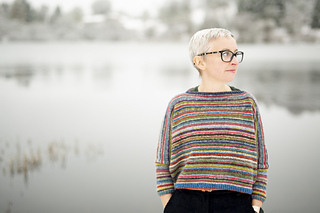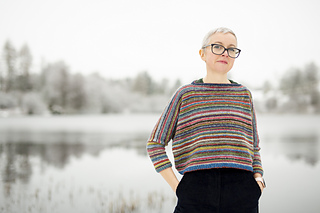patterns >  Knitting Season and 1 more...
Knitting Season and 1 more...
> Dathan pullover

















Dathan pullover
A kit to knit this sweater is available in the KDD shop
Dathan
A dolman-sleeved sweater with a slightly cropped length and (optional) steeked armscyes. Dathan is a Gaelic word for colours. 15 25g balls (1 ball of each shade) makes all sizes!
Yarn
Kate Davies Designs Milarrochy Tweed (70% Wool; 30% Mohair; 100m / 109yds per 25g ball)
All sizes: 1 ball of each of the following shades: Lochan; Ardlui; Tarbet; Smirr; Ardnamurchan; Garth; Stockiemuir; Cowslip; Cranachan; Hirst; Birkin; Hare; Bruce; Asphodel; Backen
Needles and Notions
Gauge size and below gauge-size needle(s) of your preferred length(s) for working body
Below gauge-size needle(s) of your preferred length for working neck
Gauge-size and below gauge-size needle(s) of your preferred type for working small circumferences
Stitch markers
Tapestry needle
Gauge
24 sts and 36 rounds to 10cm / 4in over stockinette worked in the round or back and forth on gauge-size needle(s)
Use 3.5mm / U.S. 4 needle as a starting point for swatching.
Sizes
To fit bust: 71-79 (81-89, 91-104, 106-119, 122-140) cm / 28-31 (32-35, 36-41, 42-47, 48-55) in.
Select the range in which your actual bust size is represented. This is an oversized, easy fitting garment. If you are unsure about which size to make, consult the sizing table. The waist measurement and arm circumference at join (just below the elbow) are the garment’s closest fitting areas. You can use these measurements as a guide. I recommend knitting a size with at least 15cm / 6in positive ease at the waist.
Shown in the first size with 25.5cm / 10in positive ease at the waist
Pattern notes
This sweater begins with a few rounds of twisted rib, and is worked in an oversized, integrated dolman shape to the underarms following the knitter’s chosen stripe sequence. Steeks can be added (to allow the upper body to be worked continuously in the round) or the knitter may choose to divide for front and back, working each piece back and forth. Extra rows are worked to raise the back; stitches are set aside for the neck opening and the two long shoulder pieces are joined by being grafted together. After the addition of the neck rib, stitches are picked up around the armscyes (which are cut open, if previously steeked) and the sleeves are worked downwards to the wrists.
To steek or not to steek?
You can choose to work the body of the sweater almost entirely in the round, by adding a pair of steeks for the armscyes, which are later cut open for the sleeves. This method has the advantage of minimising purling (which some knitters dislike) as well as reducing the number of ends (which can be cut away with the steek). If you don’t want to create and cut steeks, you can also choose to knit the upper body flat in two pieces. Simply follow the instructions for your preferred method in the pattern.

4187 projects
stashed
7836 times
- First published: February 2019
- Page created: February 15, 2019
- Last updated: August 13, 2025 …
- visits in the last 24 hours
- visitors right now





